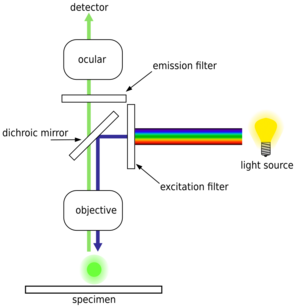Fluorescence microscope facts for kids
A fluorescence microscope is a special type of light microscope. It uses something called fluorescence to help scientists see tiny things. Imagine some materials glowing when light shines on them – that's fluorescence! This microscope makes things glow so we can study them, whether they are living cells or other materials.
Most fluorescence microscopes, especially those used to study living things, work in a specific way. This is called an "epifluorescence" design. Here's how it generally works:
- A special light shines on the tiny thing you want to see (the specimen).
- This light goes through the objective lens, which is like the main magnifying glass of the microscope.
- When the light hits the specimen, if the specimen is fluorescent, it will glow with its own light.
- This new glowing light from the specimen travels back through the objective lens.
- A special mirror, called a "dichroic beamsplitter," helps separate the light. It lets the glowing light from the specimen go through to your eye or a camera. But it sends any leftover original light back, so it doesn't get in the way.
This way, you only see the parts of the specimen that are glowing, making them stand out clearly!
Contents
How Fluorescence Works
Fluorescence is a cool trick some materials do. When they absorb light of one color (or wavelength), they quickly release light of a different color. Think of it like a glow stick: you "charge" it by bending it, and then it glows. With fluorescence, the "charge" is light!
What is Phosphorescence?
Sometimes, materials glow for a longer time after the light source is removed. This is called phosphorescence. It's similar to fluorescence but the glow lasts longer. Some glow-in-the-dark toys use phosphorescence. Fluorescence microscopes can sometimes use this too, but they mainly focus on the quick glow of fluorescence.
Why Use a Fluorescence Microscope?
Fluorescence microscopes are super useful for many reasons:
- Seeing specific things: Scientists can add special dyes to cells or tissues. These dyes stick to certain parts, like the nucleus or specific proteins. When light shines on them, only those parts glow. This helps scientists see exactly where things are.
- Studying living cells: You can watch living cells and see how they change or move. This is important for understanding diseases or how medicines work.
- High contrast: Because only the glowing parts are visible, the images are very clear and have high contrast. This makes it easier to spot tiny details.
Where are They Used?
These microscopes are used in many fields, especially in biology and medicine. For example:
- Studying cells and DNA.
- Looking at bacteria and viruses.
- Diagnosing diseases.
- Developing new medicines.
Images for kids
See also
 In Spanish: Microscopio de fluorescencia para niños
In Spanish: Microscopio de fluorescencia para niños



